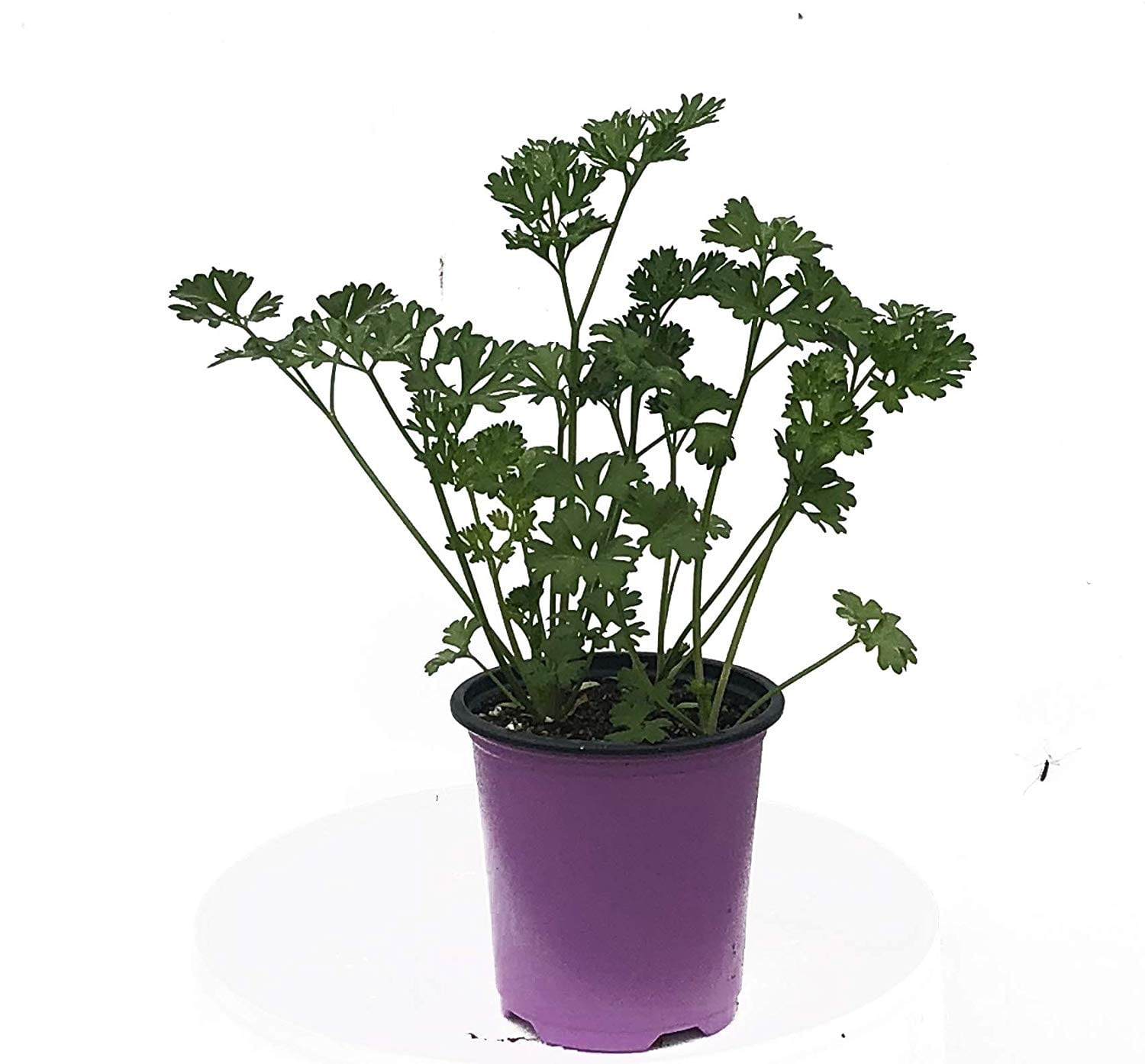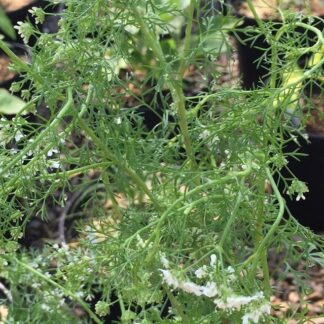Description
Petroselinum crispum, Parsley Triple Curl
Triple Curl Parsley (Petroselinum crispum) is a classic and decorative herb prized for its intricately curled leaves, mild flavor, and ornamental beauty. Often referred to simply as Curly Parsley, this variety is as visually appealing as it is versatile in the kitchen. Its crisp texture and fresh, slightly peppery taste make it an essential garnish, as well as a flavorful addition to soups, stews, salads, and sauces.
This biennial herb, grown as an annual in most climates, forms compact, dense mounds of vibrant green foliage that reach up to 12-18 inches in height. Its attractive, frilly leaves add texture and visual interest to gardens, borders, and containers, making it a popular choice for both edible and ornamental landscaping. Triple Curl Parsley is easy to grow, thrives in various conditions, and produces a continuous supply of fresh leaves throughout the growing season.
Features:
- Mild Flavor: Subtle, fresh taste perfect for garnishing and enhancing dishes.
- Ornamental Leaves: Intricately curled foliage adds beauty to gardens and plates.
- Compact Growth: Grows to 12-18 inches tall, ideal for small spaces and containers.
- High Productivity: Produces an abundance of leaves throughout the growing season.
- Cold Tolerant: Hardy in USDA zones 4-9, tolerating light frosts.
- Dual Purpose: Perfect for culinary and ornamental uses.
Growing Triple Curl Parsley
Growing Triple Curl Parsley is simple and rewarding. Follow these guidelines for a lush and productive plant:
1. Selecting the Right Location
- Light Requirements: Prefers full sun but tolerates partial shade, especially in hot climates.
- Temperature: Thrives in moderate temperatures and tolerates light frosts, making it suitable for spring and fall planting.
2. Preparing the Soil
- Soil Type: Prefers well-draining, nutrient-rich soil. Loamy soil enriched with organic matter works best.
- pH Level: Slightly acidic to neutral soil with a pH of 6.0-7.0 is ideal.
- Soil Amendments: Incorporate compost or aged manure to improve fertility and moisture retention.
3. Planting
- Timing: Sow seeds indoors 6-8 weeks before the last frost date or directly outdoors in early spring when soil temperatures reach 50°F (10°C).
- Spacing: Space plants 6-8 inches apart in rows that are 12-18 inches apart.
- Depth: Sow seeds 1/4 inch deep in well-prepared soil. Thin seedlings to the proper spacing once they emerge.
4. Watering
- Consistency: Keep the soil consistently moist but not waterlogged. Water deeply when the top inch of soil feels dry.
- Mulching: Apply a thin layer of mulch to retain soil moisture and suppress weeds.
5. Fertilizing
- Nutrient Needs: Feed with a balanced, water-soluble fertilizer every 4-6 weeks during the growing season.
- Frequency: Adjust fertilization based on soil quality; avoid over-fertilizing to prevent excessive foliage growth with reduced flavor.
6. Pruning and Maintenance
- Harvesting: Begin harvesting leaves when plants are 6-8 inches tall. Snip stems at the base to encourage new growth.
- Deadheading: Remove flower stalks as they appear to extend the productive lifespan of the plant.
- Thinning: Thin seedlings to ensure proper air circulation and prevent overcrowding.
7. Pests and Diseases
- Pests: Watch for aphids, whiteflies, and parsley worms. Use insecticidal soap or neem oil to control infestations.
- Diseases: Ensure good air circulation and avoid overhead watering to prevent fungal issues such as powdery mildew.
8. Winter Care
- In zones 7-9, Triple Curl Parsley may overwinter with minimal protection. Mulch heavily around the base to insulate roots.
- In colder climates, grow parsley in containers and move indoors to a sunny windowsill during the winter months.
Design Tips:
Triple Curl Parsley’s frilly foliage and versatility make it a valuable addition to various garden settings:
- Herb Gardens: Combine with basil, chives, and rosemary for a functional and fragrant herb garden.
- Edible Landscapes: Plant alongside vegetables and edible flowers for a practical yet attractive layout.
- Containers: Grow in pots near the kitchen for easy access to fresh herbs while cooking.
- Borders and Edging: Use as a low-growing border plant to define garden beds and pathways.
- Companion Planting: Pair with carrots, tomatoes, and roses to deter pests and enhance growth.
Culinary Uses
Triple Curl Parsley is a versatile herb that enhances a wide range of dishes:
- Garnishing: Sprinkle fresh, chopped parsley on soups, stews, and roasted vegetables for a burst of flavor and color.
- Seasoning: Use in marinades, dressings, and rubs to add depth to meats, fish, and vegetables.
- Herb Butters: Blend with butter and garlic for a flavorful spread.
- Fresh Salads: Incorporate into tabbouleh, grain bowls, or green salads for a refreshing flavor.
- Cooking: Add to soups, broths, and sautéed dishes for an aromatic touch.
Health Benefits
Triple Curl Parsley offers numerous health benefits, making it both a flavorful and nutritious addition to your diet:
- Rich in Vitamins: High in vitamins A, C, and K, supporting immune health, bone strength, and vision.
- Antioxidant Properties: Contains antioxidants like flavonoids and carotenoids that help combat free radicals.
- Digestive Support: Traditionally used to alleviate bloating and support healthy digestion.
- Detoxifying: Known for its natural diuretic properties, aiding in detoxification and kidney health.
Benefits:
- Nutritional Powerhouse: Packed with vitamins and antioxidants to support overall health.
- Culinary Versatility: Enhances a variety of dishes with its mild flavor and vibrant color.
- Low Maintenance: Easy to grow and suitable for gardens, raised beds, and containers.
- Cold Tolerant: Thrives in cooler weather and can overwinter in mild climates.
- Aesthetic Appeal: Adds texture and greenery to gardens and indoor spaces.
Petroselinum crispum, or Triple Curl Parsley, is a flavorful and decorative herb that brings beauty, nutrition, and utility to gardens and kitchens alike. Whether you’re growing it for its mild taste, ornamental appeal, or health benefits, this hardy and productive plant is a rewarding addition to any gardening endeavor. With proper care, Triple Curl Parsley will provide a continuous supply of fresh, aromatic leaves that enhance your meals and brighten your garden throughout the season. Cultivate, harvest, and enjoy this essential culinary herb in your favorite dishes and garden designs.




